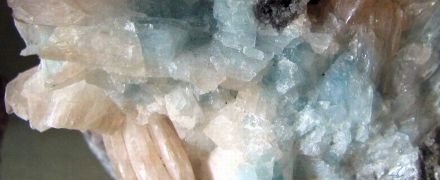open 10 am - 7 pm
laboratory is closed
Kovdorskit

Continuing the story about rare minerals used to make collectible jewelry inserts, we will talk about Kovdorskite. Kovdorskite is an aqueous magnesium phosphate and is named after the place of the first find - the Kovdor deposit in the Murmansk region. At first, this mineral was of interest only to collectors of mineralogical systematics, not pleasing with beautiful druze and crystals. But in the mid-1980s, beautiful decorative collection material began to come from the mine with relatively large Kovdorskite crystals. In addition to colorless crystals, sometimes there were pink or blue-colored crystals, as well as polychrome ones. As a rule, this material was not transparent enough to make faceted inserts. Initially, fragments of crystals with a pronounced pale blue or pink color began to be cut in the form of cabochons, then, when crystals with transparent areas began to arrive, facet cuts began to be made. The stone is not suitable for use in jewelry for everyday use, and is also very problematic in cutting: the size of the raw material is not large - about 1 carat (at the exit), and in larger stones there are significant cloudy areas. The hardness of Kovdorskite on the Mohs scale is 4, the cleavage is perfect, the raw material is often cracked, plus it is rare to find stones suitable for cutting. All this makes faceted stones with high clarity characteristics and pronounced color very rare, being the lot of collectors.
В геммологической практике бывают весьма увлекательные случаи с диагностикой ювелирных вставок
Но помимо редкости цвета и высокой стоимости таких камней, многие розовые камни выделяются одной замечательной особенностью – они проявляют плеохроизм, то есть в зависимости от положения осмотра камня он может иметь дополнительные оттенки – оранжевый или пурпурный.
Currently, gemstones are produced by two fundamentally different technological methods - the High Pressure - High Temperature method (“HPHT”, High-pressure & High-temperature) and the Chemical Vapor Deposition (“CVD”, Chemical vapor deposition) method. The "HPHT" method is the most tested classical synthesis method, which can be used both carbon deposition on diamond from flux melts and catalytic reactions. In "CVD" synthesis, diamond growth occurs on a seed during carbon deposition mainly from a gaseous medium at relatively low temperatures and pressures.
Jewelry and precious stones are just such a category of goods, when buying which you need to pay attention to many criteria.
Sogdianite is a rather rare mineral and more often it can be found as a collection material (moreover, in systematic collections), and it is extremely rare in jewelry.






